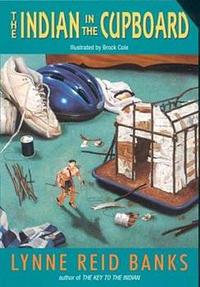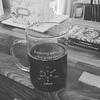Take a photo of a barcode or cover
English schoolboy Omri discovers that a cupboard found in an alleyway, in combination with a key of mysterious origin, has the oddly specific property of bringing plastic toy figures to life.
Or rather, swapping them with actual people and animals, transported from other times and appearing in miniaturized form.
The author does a good job of layering on the complications from this scenario, and comes up with some really unique problems and situations resulting from a boy suddenly trying to care for and hide several miniature people and horses.
The story does a good job with keeping consistency in its use of magic, and delivers a series of complications leading to an ending that packs some emotion.
The portrayal of Iroquois character Little Bull, trades heavily in stereotypes, and unfortunately the book's attempts to undermine those stereotypes falls short of its embracing of them.
Or rather, swapping them with actual people and animals, transported from other times and appearing in miniaturized form.
The author does a good job of layering on the complications from this scenario, and comes up with some really unique problems and situations resulting from a boy suddenly trying to care for and hide several miniature people and horses.
The story does a good job with keeping consistency in its use of magic, and delivers a series of complications leading to an ending that packs some emotion.
The portrayal of Iroquois character Little Bull, trades heavily in stereotypes, and unfortunately the book's attempts to undermine those stereotypes falls short of its embracing of them.
Kiddos enjoyed this. We had read it previously, but they had forgotten (too many years had past and they were too young).
I could not get through it. It just annoyed me with the stereotypes.
It took a long time for me to finish this with my 4 year old. We both seemed to be a little bored with it...although my boredom might have contributed to his. It's an interesting story about a magic cupboard that turns plastic toys into real little people.
I don't plan to read any more books in the series though. Most nights I would mention the book and my 4 year old wanted to read picture books instead, and he usually asks for chapter books all the time wanting to find out what happens. Moving on to something better... (Blake -July 2009)
*Read this to Blake & Clark. They both enjoyed it and once we got into it, the book went quickly. I didn't love it, but we'll still look to watch the movie. (June- July 2016)
I don't plan to read any more books in the series though. Most nights I would mention the book and my 4 year old wanted to read picture books instead, and he usually asks for chapter books all the time wanting to find out what happens. Moving on to something better... (Blake -July 2009)
*Read this to Blake & Clark. They both enjoyed it and once we got into it, the book went quickly. I didn't love it, but we'll still look to watch the movie. (June- July 2016)
I loved this book so much when I was in fourth grade, but I read it again this past year and I was shocked at how the characters were stereotyped. Perhaps the newest versions are edited to not be so, I was reading the same one I got in fourth grade, but it is always surprising to realise something I read as a child was terribly prejudicial. I certainly didn't take that away from the book, but I wonder if that would be the case with every kid, or if I was just more oblivious than most.
I bought this to read again as I remember it being one of my favorite books in elementary school. I don't remember if I read it for class or just pulled it from the school library; I did a lot of the latter back then.
I can say I still enjoyed this book upon re-reading it as an adult. With that being said, I took it for what it was: a children's book. I read a couple of the reviews that said it was written simply and childishly; of course it is written that way, it is meant for children who are still learning how to read chapter books. Alternatively, I imagine the cowboy's speaking parts would be difficult for a child to understand completely. This leads me to my next point. Those who shout about the racism, missed part of the lesson of the story. The entire beginning is about Omri learning that what he has been taught and learned through TV is *not* true and that stereotypes are *not* correct. There's also the classic Seuss lesson of "a person's a person, no matter how small" which is also the main lesson of the book, with Omri coming to the realization that it is selfish to keep a real person as a toy (this also feels anti-slavery to me). Contrary to that, the cowboy's "accent" is ridiculous and a heavy false stereotype that is never contradicted, as opposed to most of the Indian stereotypes.
This book would make a fantastic conversation starter with young children to discuss stereotypes as well as how everyone should be treated equal regardless of how they talk or how they look.
I can say I still enjoyed this book upon re-reading it as an adult. With that being said, I took it for what it was: a children's book. I read a couple of the reviews that said it was written simply and childishly; of course it is written that way, it is meant for children who are still learning how to read chapter books. Alternatively, I imagine the cowboy's speaking parts would be difficult for a child to understand completely. This leads me to my next point. Those who shout about the racism, missed part of the lesson of the story. The entire beginning is about Omri learning that what he has been taught and learned through TV is *not* true and that stereotypes are *not* correct. There's also the classic Seuss lesson of "a person's a person, no matter how small" which is also the main lesson of the book, with Omri coming to the realization that it is selfish to keep a real person as a toy (this also feels anti-slavery to me). Contrary to that, the cowboy's "accent" is ridiculous and a heavy false stereotype that is never contradicted, as opposed to most of the Indian stereotypes.
This book would make a fantastic conversation starter with young children to discuss stereotypes as well as how everyone should be treated equal regardless of how they talk or how they look.
I think I would have loved to have read this as a child.
Excellent book. Good messages of tolerance. Great possibilities for key stage two literacy. Children loved it too.
Excellent book. Good messages of tolerance. Great possibilities for key stage two literacy. Children loved it too.





